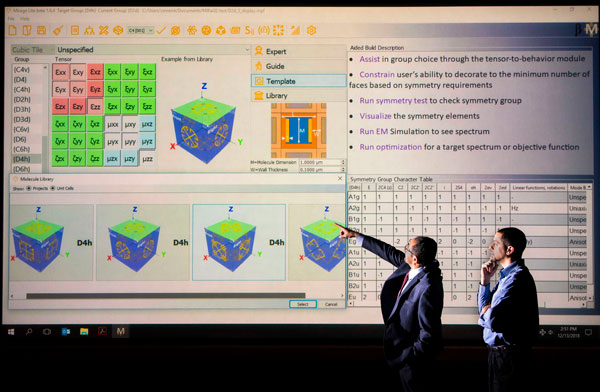Designers describe result, Mirage design aid does the rest

New software from Sandia lets users design science-fiction-like materials with the same efficiency that architects use when they draft building plans.
Sandia has created the first inverse-design software for optical metamaterials. That means users start by describing the result they want, and the software fills in the steps needed to get there. The modern design approach takes guesswork out of engineering as-yet theoretical technologies, such as ultracompact, high-performance cameras and cloaking armor that could make wearers invisible to detection.
Sandia uses the design aid, called Mirage, in its research and development programs and released a test version to select collaborators last year. Now, researchers working on government metamaterial projects can request a license at no cost.
Man-made optical metamaterials have been touted for more than a decade for their ability to manipulate light in extraordinary ways.
In theory, imaging satellites and interstellar telescopes could be dramatically smaller with metamaterial lenses one hundred times thinner than conventional ones. Or, the technology could someday lead to cloaking materials that deflect light around them, rendering objects impossible to see.
Mirage simplifies and automates the design process for materials needed to make such technologies a reality.
Optical Metamaterials
Watch a preview of Mirage, software developed by Sandia National Laboratories to make optical engineering (relatively) easy.
Mirage takes guesswork out of design
The field of optical metamaterials so far has struggled to deliver on all its perceived promise of revolutionizing optics. One difficulty for engineers has been that metamaterials are made of tiny building blocks, called meta-atoms, which can be designed in countless variations. A certain shape, collectively, might bend light. Change that shape, the size, the spacing or the material — and that might amplify or diminish the effect, or cause something entirely different to happen, like twist the light one direction or another or change its intensity or color.
“Predicting what the bulk ‘homogenized’ properties will be has been very hard to determine until now,” said Mike Fiddy, a program manager in the Defense Advanced Research Projects Agency, which funded the software’s development.
Other software can simulate what meta-atoms will do to light, but that only allows researchers to use intuition to experiment with different designs until they stumble upon or tediously work out the behavior they want.
Despite the challenge, some researchers successfully have created imaginative metamaterial devices. Sandia invented a device that converts heat to electricity, potentially for more fuel-efficient engines, as well as a light-mixing technology that could lead to a new, changeable, multicolored light source. Such a source could accelerate all kinds of research, from archeology to biomedicine.
But on the whole, said Sandia scientist Ihab El-Kady, the metamaterial enterprise has needed a boost.
“We cannot possibly solve this problem by trial and error,” said Ihab, who conceived Mirage. “Instead, we could do the opposite. We could say: ‘Here is the behavior I want. Now tell me what the metamaterial looks like.’”
No tool used this inverse-design approach. So, Ihab and his team at Sandia’s National Security Photonics Center built one.
User-friendly instructions to exploit 100-plus templates
Mirage lets users start by telling the software the optical property they want — how their metamaterial needs to interact with light — and their starting materials. Mirage generates designs that match those criteria from a library of more than 100 templates. Or, users can draw their own designs, and the program will check them for errors.

“A more systematic approach for designing metamaterials should greatly accelerate their adoption in various application areas,” eliminating more commonly used, intuition-based approaches, Fiddy said.
DARPA featured Mirage as a premier technology at the agency’s 60th Anniversary Symposium in Fort Washington, Maryland, showcasing its far-reaching uses.
“Mirage is an all-in-one tool,” Ihab said. “Not only does it tell you what the metamaterial looks like, it allows you to explore various configurations, simulate the system, validate the chosen behavior, visualize its response and optimize its functionality within your fabrication constraints.”
Software refines powerful ideas
On top of that, Mirage is useful because it includes algorithms that help researchers get the best performance from their inventions, said Sandia senior scientist Igal Brener, who uses the software in his metamaterial research.
Igal’s team previously created a material that can mix two lasers to produce 11 colors at once, including infrared and ultraviolet light. The technology could be developed into tunable lasers that replace single-color ones.
But some of those colors are too dim to be useful, so he’s exploring ways to brighten the output. Other software packages Igal has used include simple optimization algorithms. However, to use more advanced algorithms he must supplement those packages with his own coding. Not so with Mirage.
“Optimization techniques come in many different flavors,” he said. “Mirage is the only software package I know of that has the complex optimization techniques I need built in.”
If the initial launch is successful, Sandia plans to develop a second version of Mirage, tentatively called Mirage Elite, that would introduce a surge forward in optimization by automatically morphing meta-atoms into bizarre and outlandish shapes in the hunt for undiscovered behaviors.
Researchers interested in a copy of Mirage are invited to contact Sandia for more information. To be eligible for a free copy, recipients must have a valid research contract with the U.S. government. Mirage runs on Windows and can be configured to operate on laptop, desktop and multicore machines.